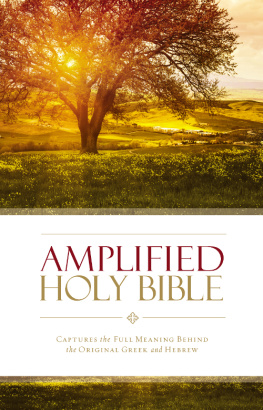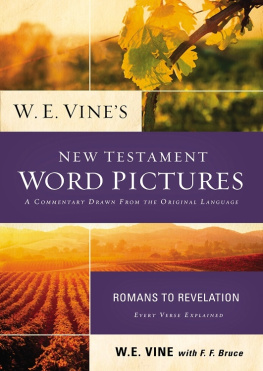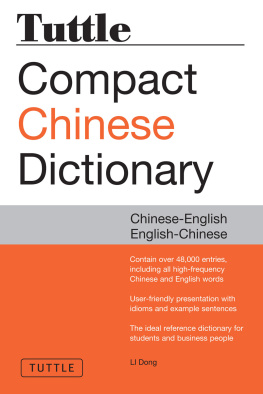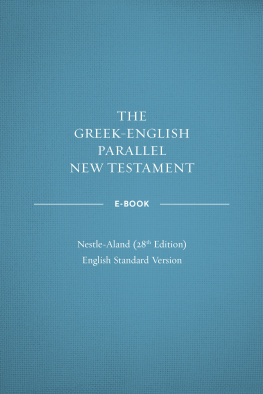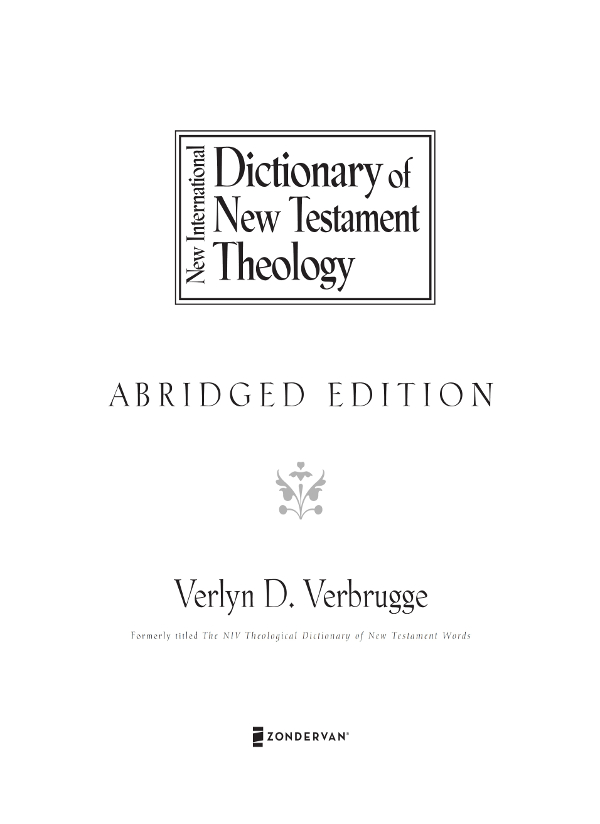To my parents
who instilled in me a love of the Scriptures
ZONDERVAN
New International Dictionary of New Testament Theology
Copyright 2000 by The Zondervan Corporation
Formerly titled: The NIV Theological Dictionary of New Testament Words
Requests for information should be addressed to:
Zondervan, 3900 Sparks Dr. SE, Grand Rapids, Michigan 49546
ePub Edition September 2017: 978-0-310-53755-7
Library of Congress Cataloging-in-Publication Data
New international dictionary of New Testament theology/ [edited by] Verlyn D. Verbrugge.Abridged ed.
p. cm.
Formerly titled: THE NIV theological dictionary of New Testament words. Includes indexes
ISBN - 13 978-0-310-25620-5
1. Bible. NT.TheologyDictionaries. 2. Greek language, BiblicalGlossaries, vocabularies, etc. I. Verbrugge, Verlyn D. II. NIV theological dictionary of New Testament words.
BS2397 .N48
225.3dc22 2003021824
All Scripture quotations, unless otherwise indicated, are taken from The Holy Bible, New International Version, NIV . Copyright 1973, 1978, 1984 by Biblica, Inc. Used by permission of Zondervan. All rights reserved worldwide. www.Zondervan.com. The NIV and New International Version are trademarks registered in the United States Patent and Trademark Office by Biblica, Inc.
All rights reserved. No part of this publication may be reproduced, stored in a retrieval system, or transmitted in any form or by any meanselectronic, mechanical, photocopy, recording, or any otherexcept for brief quotations in printed reviews, without the prior permission of the publisher.
Information about External Hyperlinks in this ebook
Please note that footnotes in this ebook may contain hyperlinks to external websites as part of bibliographic citations. These hyperlinks have not been activated by the publisher, who cannot verify the accuracy of these links beyond the date of publication.
Contents
This book is an abridgment of the popular New International Dictionary of New Testament Theology, edited by Colin Brown. This four-volume set is itself a translation of a German work, Theologisches Begriffslexikon zum Neuen Testament, published in the 1960s and early 1970s and edited by Lothar Coenen, Erich Beyreuther, and Hans Bietenhard.
But the present work is much more than an abridgment. The arrangement of the material as it occurs in NIDNTT has been completely revamped and new entries have been added. Let me explain.
1. NIDNTT is arranged according to English topics. Sometimes an English category is linked to a single Greek word, but many times two or more Greek words are discussed, all of which have nuances of the English word. This abridgment has rearranged the material so that each Greek word is discussed in its own place in Greek alphabetical order. As I examined the NIDNTT, it became apparent to me that there was often little discussion of the interrelationship of Greek words within a particular semantic field. That is, rather than being a discussion of semantic domains, NIDNTT is a discussion of individual Greek words that have been grouped together according to English meaning. It therefore made as much sense to discuss these words in their sequence in the Greek alphabet. (Note that this is the method used in the New International Dictionary of Old Testament Theology and Exegesis, edited by Willem VanGemeren and published by Zondervan in 1997.)
That does not mean that readers no longer have access to the discussions of other Greek words with similar English meanings, since (like NIDOTTE) at the end of many entries are cross-references to other Greek words. For example, the NIDNTT entry Death, Kill, Sleep discusses four Greek words and their cognates: apoktein, thanatos, katheud, and nekros. At the end of each of these words in this abridgment is a cross-reference to the other three words. You are encouraged to look up all four of these words if you want to make a thorough study of this English topic.
2. In this abridgment, each of the Greek words has a number, according to the Goodrick-Kohlenberger numbering system. This numbering system (similar but superior to Strongs) was introduced in The NIV Exhaustive Concordance, published in 1990 (available now as Zondervan NIV Exhaustive Concordance) and edited by Edward W. Goodrick and John R. Kohlenberger III. (The same numbering system forms the basis of The Greek-English Concordance to the New Testament and The Exhaustive Concordance to the Greek New Testament.) Thus, if you use the New International Version ( NIV ), you can look up an English word in the Exhaustive Concordance, find its corresponding GK number, and turn to that number in this abridgment for a discussion of that word. An easier means of finding GK numbers is The NIV English-Greek New Testament, by William D. Mounce. This book contains the running text of the NIV with Greek words rearranged underneath the English words, together with parsing information and the GK number of each word.
If you use a reference work that has Strongs numbers, conversion charts are available in the back of the present work.
3. Even though the initial lexical paragraph of each entry in this abridgment has Greek words written in Greek letters (always followed by transliteration), the rest of the entry uses only transliteration. Therefore you can read and understand this theological dictionary even if you do not know Greek. And you can easily find the cross-reference entries as well, since these too are cited both by Greek transliteration and by GK number.
4. Some material is obviously deleted in any abridgment. So what has been deleted from NIDNTT? (a) As a matter of policy, all references to secondary literature, including the extensive bibliographies, have been eliminated. These references only went as far as the mid-1970s (when the four-volume set was published), so these scholarly references are dated. If you want to know which works were consulted for any particular article in NIDNTT, you can go to the larger work for that information.
(b) NIDNTT also contained a number of full-length articles on specific topics, such as Revelation in Contemporary Theology and Infant Baptism: Its Background and Theology. These articles fit more in the category of systematic theology than that of biblical exegesis; in addition, they too are dated. Thus, they have been eliminated.
(c) Some articles of NIDNTT discussed the pros and cons of various interpretations of particular passages of Scripture. In general I have eliminated these discussions and simply given the conclusions. Also, in NIDNTT the editors made various additions to certain German original articles in order to make their content more palatable to evangelical Christians; sometimes these added comments even contradicted the original. In this abridgment, each article is a homogenous whole rather than a hybrid and is written from a thorough evangelical perspective.
(d) The discussion of the history of a particular word in classical Greek has usually been abbreviated more substantially than the rest of the original article. The important thing for the exegete to know is how a particular word was used in Hellenistic Greek, not what its presumed root meant nor how it was used in Homer, Hesiod, Plato, Aristotle, and the like. Furthermore, sometimes the authors of





